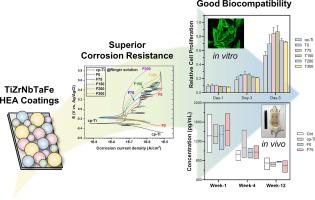Mechanical properties and biocompatibility evaluation of TiZrNbTaFe high entropy alloy films deposited using a hybrid HiPIMS and RF sputtering system
IF 5.3
2区 材料科学
Q1 MATERIALS SCIENCE, COATINGS & FILMS
引用次数: 0
Abstract
Given the well-documented low biocompatibility issues associated with conventional metallic biomaterials, there is an urgent need to develop new biomaterials. Biological high entropy alloys (HEAs), designed with non-toxic elements for biomedical applications, represent a significant advancement in metal biomedical materials due to their tunable mechanical properties and excellent biological safety. This study employed a hybrid system that combined a high power impulse magnetron sputtering (HiPIMS) power with a radio frequency (RF) power to synthesize a series of amorphous TiZrNbTaFe HEA coatings, in which the Ti content was varied by changing the RF power applied to the Ti target. One exemplary TiZrNbTaFe film, deposited with a Ti target RF power of 75 W, was thoroughly examined. This film demonstrated several highly promising attributes as a novel metallic biomaterial, including a dense and fine microstructure, good adhesion quality, superior corrosion resistance, and exceptional biocompatibility both in vitro and in vivo. These findings could provide new insights for innovative biomaterials development and help address long-term implantation and implant failure issues.

使用混合 HiPIMS 和射频溅射系统沉积的 TiZrNbTaFe 高熵合金薄膜的力学性能和生物相容性评估
传统金属生物材料的生物相容性较低,这一点已得到充分证实,因此迫切需要开发新型生物材料。生物高熵合金(HEAs)采用无毒元素设计,适用于生物医学应用,由于其可调整的机械性能和出色的生物安全性,代表了金属生物医学材料的重大进步。本研究采用了一种混合系统,将高功率脉冲磁控溅射(HiPIMS)功率与射频(RF)功率相结合,合成了一系列非晶态 TiZrNbTaFe HEA 涂层,其中 Ti 的含量可通过改变施加到 Ti 靶材上的射频功率而改变。我们对钛靶射频功率为 75 W 时沉积的一种示范性 TiZrNbTaFe 薄膜进行了深入研究。作为一种新型金属生物材料,该薄膜表现出多种极具潜力的特性,包括致密精细的微观结构、良好的粘附性、卓越的耐腐蚀性以及在体内外均具有优异的生物相容性。这些发现可为创新生物材料的开发提供新的见解,并有助于解决长期植入和植入失败的问题。
本文章由计算机程序翻译,如有差异,请以英文原文为准。
求助全文
约1分钟内获得全文
求助全文
来源期刊

Surface & Coatings Technology
工程技术-材料科学:膜
CiteScore
10.00
自引率
11.10%
发文量
921
审稿时长
19 days
期刊介绍:
Surface and Coatings Technology is an international archival journal publishing scientific papers on significant developments in surface and interface engineering to modify and improve the surface properties of materials for protection in demanding contact conditions or aggressive environments, or for enhanced functional performance. Contributions range from original scientific articles concerned with fundamental and applied aspects of research or direct applications of metallic, inorganic, organic and composite coatings, to invited reviews of current technology in specific areas. Papers submitted to this journal are expected to be in line with the following aspects in processes, and properties/performance:
A. Processes: Physical and chemical vapour deposition techniques, thermal and plasma spraying, surface modification by directed energy techniques such as ion, electron and laser beams, thermo-chemical treatment, wet chemical and electrochemical processes such as plating, sol-gel coating, anodization, plasma electrolytic oxidation, etc., but excluding painting.
B. Properties/performance: friction performance, wear resistance (e.g., abrasion, erosion, fretting, etc), corrosion and oxidation resistance, thermal protection, diffusion resistance, hydrophilicity/hydrophobicity, and properties relevant to smart materials behaviour and enhanced multifunctional performance for environmental, energy and medical applications, but excluding device aspects.
 求助内容:
求助内容: 应助结果提醒方式:
应助结果提醒方式:


